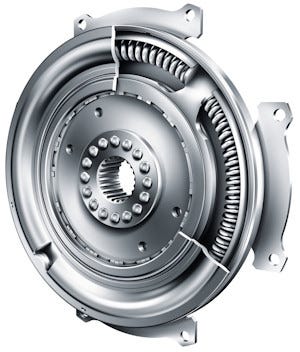October 26, 2016

The Schaeffler Group, a leading global integrated automotive and industrial supplier with its INA, LuK and FAG brands, has spent decades designing and manufacturing damper and torsion-control technologies for automotive applications. Now, these same technologies are starting to be used in tractors to make the ride in these utilitarian vehicles just as quiet and smooth.
Earlier this year, Eric Berndt, Schaeffler Engine and Driveline Technologies Specialist, delivered a talk entitled “Applying Automotive Technology to Agriculture” at the AMC Engineering Conference in Waterloo, Iowa.
According to Berndt, damper and torsion-control technologies are in great demand these days, due in large part to the new lower-emission engines that tractor makers are being required to build.

The arc spring damper has parts that rotate against each other in bearings and are supported by two long arc springs. The design dampens engine vibrations. (Photo credit: Schaeffler Group)
“As the new diesel engines have to meet the stricter emission standards, they also produce more vibration,” explains Berndt. “Tractor manufacturers have to find effective ways to control the higher vibration coming out of the new engines so it doesn’t carry through to the operator of the tractor.”
As Berndt puts it, the primary goal of these dampening control technologies is to increase the comfort and reduce the wear and fatigue for the operators. “So that is what we were trying to get at through some of these technologies.”
From autos to off-road
Per Berndt, typically some of the most advanced dampening and torsion-control technologies have, until now, been reserved for cars and light trucks. “So we are taking those advanced dampening technologies and bringing them over from the world of automotive and carrying them into tractors so you can enjoy the same level of comfort you have in your car.”
The type of technology Berndt is talking about is referred to as a “torsional damper.” This device controls the rotating energy from the engine and prevents the vibration that results from that energy from going into the transmission and the rest of vehicle, so the operator won’t feel it.
There are different levels of the technology that can achieve that desired effect. “Currently what is typically used on tractors is what we call a ‘straight spring damper,’” explains Berndt. “The next level is the ‘arc spring damper,’ and coming soon are pendulum absorbers.”

Eric Berndt, Schaeffler Group
The first level, the straight spring damper, is already used in many tractor applications, according to Berndt. The next level, the arc spring damper, is starting to see increased usage outside automotive applications.
So, how will farmers know if the tractor they are buying is equipped with the latest dampening technology?
“They will know when they are in vehicle and if they notice there is excessive vibration or noise,” Berndt is quick to point out. “It is one of those things that is buried inside and that you wouldn’t normally ask for, unlike an Intel processor in your computer. Farmers wouldn’t really know about it, but what they would know is how much vibration they feel when the vehicle is operating.”
Berndt goes on to explain that by continuing to reduce the noise and vibration that the operator feels, tractor manufacturers are trying to reduce operator fatigue, which allows the farmer to work longer and more accurately. “Again, it is these new types of dampening and torsion-control technologies that allow the tractor manufacturer to do this for the end user.”
How “arc spring dampers” work:
There are a variety of dampers that can absorb the vibration and noise you feel when operating a motorized vehicle. Arc spring dampers are one of the newest types, built to withstand the high levels of vibration and noise associated with the large, reduced-emission diesel engines. The one shown here is made by Schaeffler.
The arc spring damper consists of a primary side that is bolted to the flywheel, and a secondary side that is connected with the transmission input shaft, according to the company. The parts can rotate against one another in bearings and are supported on two long arc springs. Schaeffler explains that this results in very gentle characteristics with an extremely long wind-up angle. The springs are located in an encapsulated channel that is filled with grease and rest on hardened guide shells.
About the Author(s)
You May Also Like




